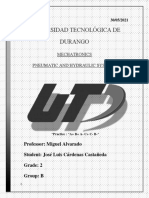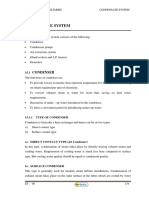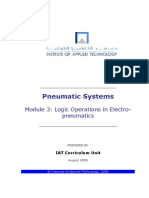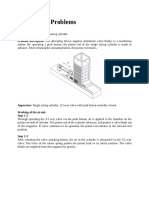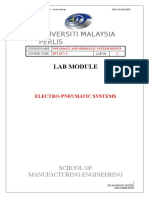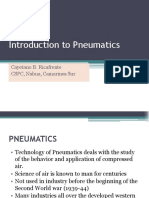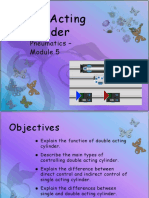Basic Pneumatics: Module 5: Double Acting Cylinder
Basic Pneumatics: Module 5: Double Acting Cylinder
Uploaded by
احمد السيدCopyright:
Available Formats
Basic Pneumatics: Module 5: Double Acting Cylinder
Basic Pneumatics: Module 5: Double Acting Cylinder
Uploaded by
احمد السيدOriginal Description:
Original Title
Copyright
Available Formats
Share this document
Did you find this document useful?
Is this content inappropriate?
Copyright:
Available Formats
Basic Pneumatics: Module 5: Double Acting Cylinder
Basic Pneumatics: Module 5: Double Acting Cylinder
Uploaded by
احمد السيدCopyright:
Available Formats
Basic Pneumatics
Module 5: Double acting cylinder
PREPARED BY
Academic Services
April 2012
Applied Technology High Schools, 2012
ATM 1132 Basic Pneumatics
Module 5: Double acting cylinder
Module Objectives
After the completion of this module, the student will be able to:
Explain the function of double acting cylinder.
Describe the main mehods of controlling double acting
cylinder.
Explain the difference between direct control and indirect
control of Double acting cylinder.
Explain the differences between single and double acting
cylinder.
Draw the required circuit diagram as per the given
specifications.
Simulate the pneumatic circuit as per the given
specifications by using FluidSIM software.
Module Contents
Topic Page No.
1 Comparison between single and double acting cylinder 3
2 Function of double acting cylinder 4
3 Control circuit of a double acting cylinder 5
4 Types of control of pneumatic cylinders 6
5 Practical task 1 (Stopping milk bottles) 7
6 Supplementary resources 10
7 References 10
8 Worksheet 12
2 Module 5: Double acting cylinder
ATM 1132 Basic Pneumatics
1 Double acting cylinder
Double acting cylinder is considered to be as a main actuator in any
pneumatic systems. Double acting cylinders are more expensive than
single acting cylinders, but double acting cylinders are superior to single
acting cylinders by many other important measure. Double action
cylinders are faster and stronger. In industrial applications, single
action cylinders are used in few applications, but when speed and force
are important double acting cylinders are employed.
Applications of a double acting cylinder include
1. Opening and closing doors,
2. Taking things off conveyor belts and putting things on conveyor
belts.
3. Lifting and moving packages around.
4. Presses and punches.
1.1 Comparison between single acting cylinder and double acting
cylinder
Serial Single acting cylinder Double acting cylinder
1 It has one port. It has two ports.
2 It has a spring. It has no spring.
It exerts force in one It exerts force in two directions
3
direction only. (forward and backward).
4 It uses compressed air in It uses compressed air in both
the forward stroke while strokes forward and backward.
the return stroke is
Module 5: double acting cylinder 3
ATM 1132 Basic Pneumatics
achieved by the spring.
4 Module 5: Double acting cylinder
ATM 1132 Basic Pneumatics
2.1 Function of the double acting
cylinder
Double acting cylinder is an output device
that converts the pressure energy to a
mechanical energy (linear motion in
two directions). The double acting
(a) Double acting
cylinder is shown in Fig. (5.1.a) cylinder
The ISO symbol of the double acting
cylinder is shown in Fig. (5.1.b)
2.1 Way of operation
Double acting cylinder as mentioned has
two ports and the air is applied in both (b) ISO symbol of
double acting cylinder
directions (forward and backward)
2.1.1 Forward (advance) stroke
The air is supplied to port (1) and the
exhaust air is forced out through port (2)
as illustrated in Fig. (5.1.c)
2.1.2 Backward (return) stroke:
The air is supplied to port (2) and the (c) Double acting cylinder
advanced stroke
exhaust air is forced out through port (1)
as illustrated in Fig. (5.1.d)
Note: The force produced by the
piston during the advance stroke is
greater than the force produced
(d) Double acting cylinder
during the return stroke due to the return stroke
area difference between the two sides
of the piston. Fig. 5.1
Module 5: double acting cylinder 5
ATM 1132 Basic Pneumatics
Control circuit for the Double-acting cylinder 3
The piston rod of a double-acting cylinder is to advance when a 5/2 selector
valve is operated and to return to the initial position when the selector switch is
back to the normal position. The double-acting cylinder can carry out work in
both directions of motion, due to the full air supply pressure being available for
extension and retraction.
The direct control circuit in Fig. 5.2 includes the following primary
:features
Double-acting cylinder.
5/2-way valve (selector switch)
Supply air source connected to the 5/2-way valve.
Tube connection between valve and cylinder.
Fig 5.2 control of double acting cylinder
6 Module 5: Double acting cylinder
ATM 1132 Basic Pneumatics
4 Types of control of a pneumatic cylinder
1- Direct control
2- Indirect control
Direct control of a pneumatic cylinder 4.1
The simplest level of control for the single or double-acting cylinder
involves direct control signals. With this, the cylinder is actuated
directly via a manually or mechanically actuated valve, without
any intermediate switching of additional directional control
valves. If the port sizes and the flow values of the valve are too large,
the operating forces required may be too great for direct manual
operation.
:Reference values for limits of direct cylinder control
Cylinder with piston diameter smaller than 40 mm
Valves with connection sizes smaller than 1/4"
Indirect control of a pneumatic cylinder 4.2
Cylinders with a large piston diameter have a high air
requirement. A control element with high nominal flow rate must be
used to actuate these. If the force should prove too high for a manual
actuation of the valve, then an indirect actuation should be constructed,
whereby a signal is generated via a second smaller valve, which will
provide the force necessary to switch the control element.
Module 5: double acting cylinder 7
ATM 1132 Basic Pneumatics
Practical Task 1: Stopping milk bottles 5
5.1 Learning objectives:
Upon the completion of this task, the student will be
o Able to explain and setup indirect control.
o Familiar with the mode of operation of a 5/2 way-valve with
pneumatic actuation.
o Familiar with the difference between direct and indirect control.
5.2 Task description:
A filling system fills bottles with milk. The bottles are fed to the system on
a conveyor belt and are stopped underneath the filler using pneumatic
cylinders. The double acting cylinder 1A1 (due to its large size) has to be
controlled indirectly. Fig; (5.5) shows the positional sketch of this
machine
Fig. (5.5) Positional sketch
8 Module 5: Double acting cylinder
ATM 1132 Basic Pneumatics
5.3 Task requirements:
1. Draw pneumatic circuit that controls the double acting cylinder
(1A1) indirectly. You may use the provided space below.
2. Simulate the circuit using FluidSIM software.
3. Assemble the circuit practically and check its operation.
4. Write down your observation below
Draw the pneumatic circuit here
Module 5: double acting cylinder 9
ATM 1132 Basic Pneumatics
5.4 Solution
Fig. 5.6 Solution of practical task 2
10 Module 5: Double acting cylinder
ATM 1132 Basic Pneumatics
5.5 Solution description
In the initial position, the double-acting cylinder 1A1 is retracted.
A 5/2-way single pilot valve is used to actuate the cylinder. Connection 2
& 4 of the valve 1V1 is connected to the cylinder; connection 4 is
exhausted to atmosphere via connection 5.
The valve 1S1 is actuated when the push button is activated and pressure
is applied to the control port 14 of the control valve 1V1.
The control valve 1V1 is actuated against spring force and is thus
switched to flow.
The pressure building up at the cylinder piston causes the cylinder piston
rod of the double-acting cylinder to extend.
The signal at the control port 14 remains as long as the push button is
operated. Once the piston rod has reached end position, it returns only
after the push button has been released.
When the push button is released, the valve 1S1 returns to its initial
position. Control port 14 of the control valve 1V1 exhausts to atmosphere
and the signal is reset. The control valve also returns to initial position.
The return spring causes the cylinder to retract. The air from the cylinder
chamber is exhausted to atmosphere via the control valve.
6. For further reading, you can use the following links:
1- www.Fest-didactic.com
2- http://www.eng2all.com/vb/t28932.html
3- http://www.logiclab.hu/lesson.php?fe=2
7. Supplementary recourses
1. Pneumatics video from Festo.
2. FluidSIM software.
8. References
1- Festo manuals and workbook TP101
2- Festo manuals and textbook TP101
Module 5: double acting cylinder 11
ATM 1132 Basic Pneumatics
Students notes
............................................................................................................
............................................................................................................
............................................................................................................
............................................................................................................
............................................................................................................
............................................................................................................
............................................................................................................
............................................................................................................
............................................................................................................
............................................................................................................
............................................................................................................
............................................................................................................
............................................................................................................
............................................................................................................
............................................................................................................
............................................................................................................
............................................................................................................
............................................................................................................
............................................................................................................
............................................................................................................
............................................................................................................
12 Module 5: Double acting cylinder
ATM 1132 Basic Pneumatics
Worksheet 1
Draw the symbol of double acting cylinder
What is the function of double acting cylinder?
It converts the pressure energy to a mechanical energy to give linear
motion in two directions.
What is the difference between single and double acting cylinder?
Serial Single acting cylinder Double acting cylinder
1 It has one port. It has two ports.
2 It has a spring. It has no spring.
It exerts force in one It exerts force in two directions
3
direction only. (forward and backward).
It uses compressed air in
the forward stroke while It uses compressed air in both
4
the return stroke is strokes forward and backward.
achieved by the spring.
Draw a simple circuit to control a double acting cylinder directly.
Module 5: double acting cylinder 13
ATM 1132 Basic Pneumatics
14 Module 5: Double acting cylinder
You might also like
- Level 1 Pneumatics Exercises Grey Logo Version Feb 2012 PDFNo ratings yetLevel 1 Pneumatics Exercises Grey Logo Version Feb 2012 PDF89 pages
- Exercise 13: Conveyor Belt: 1: Problem DescriptionNo ratings yetExercise 13: Conveyor Belt: 1: Problem Description10 pages
- Level 1 Pneumatics Answers For ExercisesNo ratings yetLevel 1 Pneumatics Answers For Exercises22 pages
- Pneumatic Systems: Module 2: Direct and Indirect Control in Electro-PneumaticsNo ratings yetPneumatic Systems: Module 2: Direct and Indirect Control in Electro-Pneumatics19 pages
- Electropneumatics - Relay Control SystemNo ratings yetElectropneumatics - Relay Control System35 pages
- Module 3: Electropneumatics: Relay Control SystemNo ratings yetModule 3: Electropneumatics: Relay Control System36 pages
- Lab No 7 - Introduction To Electro PneumaticsNo ratings yetLab No 7 - Introduction To Electro Pneumatics4 pages
- Electropneumatic and Hydraulic DNT241: Experiment No. 4No ratings yetElectropneumatic and Hydraulic DNT241: Experiment No. 47 pages
- Lab No 4 - Speed Control of Double Acting CylindersNo ratings yetLab No 4 - Speed Control of Double Acting Cylinders6 pages
- Assignment 7 - Fluidsim Pneumatics - Group 2No ratings yetAssignment 7 - Fluidsim Pneumatics - Group 210 pages
- Chapter 5-Pneumatic System - Multi Actuator Circuit (Version 3)No ratings yetChapter 5-Pneumatic System - Multi Actuator Circuit (Version 3)50 pages
- Pneumatic Symbol Logic Gates Truth TableNo ratings yetPneumatic Symbol Logic Gates Truth Table3 pages
- Lab No 3 - Pressure Dependent Control and Time-Delay ValveNo ratings yetLab No 3 - Pressure Dependent Control and Time-Delay Valve5 pages
- Electro-Pneumatics: Prepared by Approved byNo ratings yetElectro-Pneumatics: Prepared by Approved by30 pages
- Learning Outcomes:: Module 1 - Introduction To Pneumatics (LAB)No ratings yetLearning Outcomes:: Module 1 - Introduction To Pneumatics (LAB)6 pages
- Chapter 8: Fluid Basic Electrical and Logic Control SystemNo ratings yetChapter 8: Fluid Basic Electrical and Logic Control System34 pages
- 16 - Introduction To Electro PneumaticsNo ratings yet16 - Introduction To Electro Pneumatics18 pages
- Electro-Pneumatics Module 5 Teacher (Updated) 2No ratings yetElectro-Pneumatics Module 5 Teacher (Updated) 236 pages
- Basic Pneumatic and Electro Pneumatics Working Principle - Free Ebooks Download0% (2)Basic Pneumatic and Electro Pneumatics Working Principle - Free Ebooks Download7 pages
- Hydraulics & Pneumatics: Introduction To Electro-PneumaticsNo ratings yetHydraulics & Pneumatics: Introduction To Electro-Pneumatics67 pages
- Southern Luzon State University: College of Engineering Mechanical Engineering DepartmentNo ratings yetSouthern Luzon State University: College of Engineering Mechanical Engineering Department8 pages
- Lab No 1 - Direct and Indirect Control of CylindersNo ratings yetLab No 1 - Direct and Indirect Control of Cylinders5 pages
- Huffman Coding and Encoding Data MethodsNo ratings yetHuffman Coding and Encoding Data Methods6 pages
- Elementary Numerical Analysis: NPTEL Lectures OnNo ratings yetElementary Numerical Analysis: NPTEL Lectures On1 page
- Elementary Numerical Analysis: NPTEL Lectures OnNo ratings yetElementary Numerical Analysis: NPTEL Lectures On2 pages
- Elementary Numerical Analysis: NPTEL Lectures OnNo ratings yetElementary Numerical Analysis: NPTEL Lectures On2 pages
- Elementary Numerical Analysis: NPTEL Lectures OnNo ratings yetElementary Numerical Analysis: NPTEL Lectures On1 page
- Elementary Numerical Analysis: NPTEL Lectures OnNo ratings yetElementary Numerical Analysis: NPTEL Lectures On2 pages
- Elementary Numerical Analysis: NPTEL Lectures OnNo ratings yetElementary Numerical Analysis: NPTEL Lectures On2 pages
- As 2360.1.3-1993 Measurement of Fluid Flow in Closed Conduits Pressure Differential Methods - Measurement UsiNo ratings yetAs 2360.1.3-1993 Measurement of Fluid Flow in Closed Conduits Pressure Differential Methods - Measurement Usi10 pages
- Kandhkot Field Gas Compressor Station Introduction.100% (1)Kandhkot Field Gas Compressor Station Introduction.17 pages
- Active Fire Protection Systems Include Standpipe, Sprinkler, and Spray Systems Designed To Extinguish The Fire Outright orNo ratings yetActive Fire Protection Systems Include Standpipe, Sprinkler, and Spray Systems Designed To Extinguish The Fire Outright or5 pages
- Isolation of Process Equipment in Oil Gas ProjectNo ratings yetIsolation of Process Equipment in Oil Gas Project18 pages
- Rifeng Pricelist Conduit 1 December 2021No ratings yetRifeng Pricelist Conduit 1 December 20212 pages
- Gas Turbine Power Plant: Submitted By-Hiten (2K19/EE/113) Khursheed Aqueeb (2K19/EE/135)No ratings yetGas Turbine Power Plant: Submitted By-Hiten (2K19/EE/113) Khursheed Aqueeb (2K19/EE/135)16 pages
- Manual: Rotary Positive Displacement BlowerNo ratings yetManual: Rotary Positive Displacement Blower64 pages
- Consep Condenser / Separator Installation, Maintenance and InspectionNo ratings yetConsep Condenser / Separator Installation, Maintenance and Inspection4 pages
- GF 6320 Thermostatic Balancing Valves - CSI Format SpecificationNo ratings yetGF 6320 Thermostatic Balancing Valves - CSI Format Specification4 pages
- Gas Control & Regulation Products: Solenoid, Motorised & Pneumatic Control ValvesNo ratings yetGas Control & Regulation Products: Solenoid, Motorised & Pneumatic Control Valves2 pages
- Computational and Experimental Study On The Water-Jet Pump PerformanceNo ratings yetComputational and Experimental Study On The Water-Jet Pump Performance8 pages
- DIN Version: T 8015 EN Series 240 Type 3241-1 and Type 3241-7 Pneumatic Control Valves Type 3241 Globe ValveNo ratings yetDIN Version: T 8015 EN Series 240 Type 3241-1 and Type 3241-7 Pneumatic Control Valves Type 3241 Globe Valve8 pages
- Level 1 Pneumatics Exercises Grey Logo Version Feb 2012 PDFLevel 1 Pneumatics Exercises Grey Logo Version Feb 2012 PDF
- Exercise 13: Conveyor Belt: 1: Problem DescriptionExercise 13: Conveyor Belt: 1: Problem Description
- Pneumatic Systems: Module 2: Direct and Indirect Control in Electro-PneumaticsPneumatic Systems: Module 2: Direct and Indirect Control in Electro-Pneumatics
- Electropneumatic and Hydraulic DNT241: Experiment No. 4Electropneumatic and Hydraulic DNT241: Experiment No. 4
- Lab No 4 - Speed Control of Double Acting CylindersLab No 4 - Speed Control of Double Acting Cylinders
- Chapter 5-Pneumatic System - Multi Actuator Circuit (Version 3)Chapter 5-Pneumatic System - Multi Actuator Circuit (Version 3)
- Lab No 3 - Pressure Dependent Control and Time-Delay ValveLab No 3 - Pressure Dependent Control and Time-Delay Valve
- Learning Outcomes:: Module 1 - Introduction To Pneumatics (LAB)Learning Outcomes:: Module 1 - Introduction To Pneumatics (LAB)
- Chapter 8: Fluid Basic Electrical and Logic Control SystemChapter 8: Fluid Basic Electrical and Logic Control System
- Basic Pneumatic and Electro Pneumatics Working Principle - Free Ebooks DownloadBasic Pneumatic and Electro Pneumatics Working Principle - Free Ebooks Download
- Hydraulics & Pneumatics: Introduction To Electro-PneumaticsHydraulics & Pneumatics: Introduction To Electro-Pneumatics
- Southern Luzon State University: College of Engineering Mechanical Engineering DepartmentSouthern Luzon State University: College of Engineering Mechanical Engineering Department
- Lab No 1 - Direct and Indirect Control of CylindersLab No 1 - Direct and Indirect Control of Cylinders
- As 2360.1.3-1993 Measurement of Fluid Flow in Closed Conduits Pressure Differential Methods - Measurement UsiAs 2360.1.3-1993 Measurement of Fluid Flow in Closed Conduits Pressure Differential Methods - Measurement Usi
- Kandhkot Field Gas Compressor Station Introduction.Kandhkot Field Gas Compressor Station Introduction.
- Active Fire Protection Systems Include Standpipe, Sprinkler, and Spray Systems Designed To Extinguish The Fire Outright orActive Fire Protection Systems Include Standpipe, Sprinkler, and Spray Systems Designed To Extinguish The Fire Outright or
- Gas Turbine Power Plant: Submitted By-Hiten (2K19/EE/113) Khursheed Aqueeb (2K19/EE/135)Gas Turbine Power Plant: Submitted By-Hiten (2K19/EE/113) Khursheed Aqueeb (2K19/EE/135)
- Consep Condenser / Separator Installation, Maintenance and InspectionConsep Condenser / Separator Installation, Maintenance and Inspection
- GF 6320 Thermostatic Balancing Valves - CSI Format SpecificationGF 6320 Thermostatic Balancing Valves - CSI Format Specification
- Gas Control & Regulation Products: Solenoid, Motorised & Pneumatic Control ValvesGas Control & Regulation Products: Solenoid, Motorised & Pneumatic Control Valves
- Computational and Experimental Study On The Water-Jet Pump PerformanceComputational and Experimental Study On The Water-Jet Pump Performance
- DIN Version: T 8015 EN Series 240 Type 3241-1 and Type 3241-7 Pneumatic Control Valves Type 3241 Globe ValveDIN Version: T 8015 EN Series 240 Type 3241-1 and Type 3241-7 Pneumatic Control Valves Type 3241 Globe Valve

